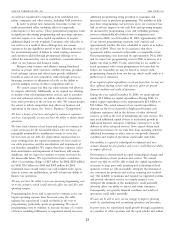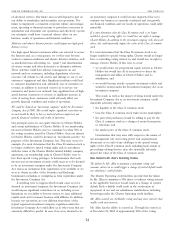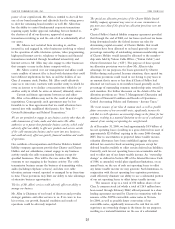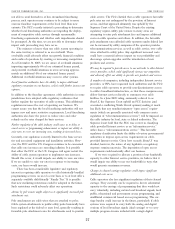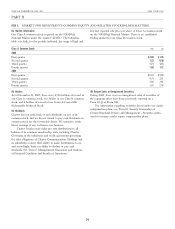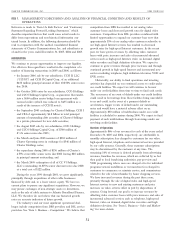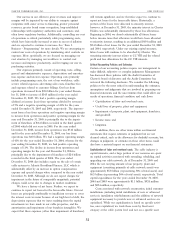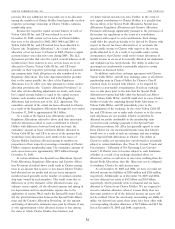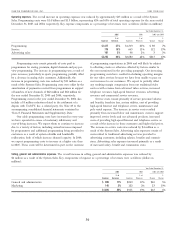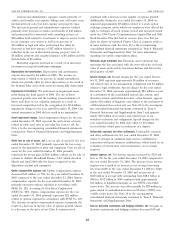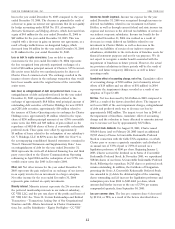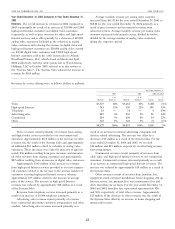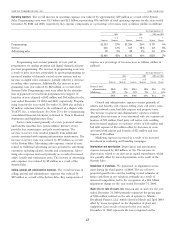Charter 2005 Annual Report Download - page 43
Download and view the complete annual report
Please find page 43 of the 2005 Charter annual report below. You can navigate through the pages in the report by either clicking on the pages listed below, or by using the keyword search tool below to find specific information within the annual report.
CHARTER COMMUNICATIONS, INC. 2005 FORM 10-K
basis. Costs capitalized as part of initial customer installations such as dispatch, that directly assist with capitalizable installa-
include materials, direct labor, and certain indirect costs (‘‘over- tion activities, and (iv) indirect costs directly attributable to
head’’). These indirect costs are associated with the activities of capitalizable activities.
personnel who assist in connecting and activating the new While we believe our existing capitalization policies are
service and consist of compensation and overhead costs associ- appropriate, a significant change in the nature or extent of our
ated with these support functions. The costs of disconnecting system activities could affect management’s judgment about the
service at a customer’s dwelling or reconnecting service to a extent to which we should capitalize direct labor or overhead in
previously installed dwelling are charged to operating expense in the future. We monitor the appropriateness of our capitalization
the period incurred. Costs for repairs and maintenance are policies, and perform updates to our internal studies on an
charged to operating expense as incurred, while equipment ongoing basis to determine whether facts or circumstances
replacement and betterments, including replacement of cable warrant a change to our capitalization policies. We capitalized
drops from the pole to the dwelling, are capitalized. internal direct labor and overhead of $190 million, $164 million
We make judgments regarding the installation and con- and $174 million, respectively, for the years ended December 31,
struction activities to be capitalized. We capitalize direct labor 2005, 2004 and 2003. Capitalized internal direct labor and
and overhead using standards developed from actual costs and overhead costs have increased in 2005 as a result of the use of
applicable operational data. We calculate standards for items more internal labor for capitalizable installations rather than
such as the labor rates, overhead rates and the actual amount of third party contractors.
time required to perform a capitalizable activity. For example, Useful lives of property, plant and equipment. We evaluate the
the standard amounts of time required to perform capitalizable appropriateness of estimated useful lives assigned to our prop-
activities are based on studies of the time required to perform erty, plant and equipment, based on annual analyses of such
such activities. Overhead rates are established based on an useful lives, and revise such lives to the extent warranted by
analysis of the nature of costs incurred in support of capitaliz- changing facts and circumstances. Any changes in estimated
able activities and a determination of the portion of costs that is useful lives as a result of these analyses, which were not
directly attributable to capitalizable activities. The impact of significant in the periods presented, will be reflected prospec-
changes that resulted from these studies were not significant in tively beginning in the period in which the study is completed.
the periods presented. The effect of a one-year decrease in the weighted average
Labor costs directly associated with capital projects are remaining useful life of our property, plant and equipment
capitalized. We capitalize direct labor costs associated with would be an increase in depreciation expense for the year ended
personnel based upon the specific time devoted to network December 31, 2005 of approximately $232 million. The effect of
construction and customer installation activities. Capitalizable a one-year increase in the weighted average useful life of our
activities performed in connection with customer installations property, plant and equipment would be a decrease in deprecia-
include such activities as: tion expense for the year ended December 31, 2005 of
(Dispatching a ‘‘truck roll’’ to the customer’s dwelling for approximately $172 million.
service connection; Depreciation expense related to property, plant and equip-
ment totaled $1.5 billion, $1.5 billion and $1.5 billion, represent-
(Verification of serviceability to the customer’s dwelling (i.e., ing approximately 31%, 21% and 34% of costs and expenses, for
determining whether the customer’s dwelling is capable of the years ended December 31, 2005, 2004 and 2003, respec-
receiving service by our cable network and/or receiving tively. Depreciation is recorded using the straight-line composite
advanced or Internet services); method over management’s estimate of the estimated useful
(Customer premise activities performed by in-house field lives of the related assets as listed below:
technicians and third-party contractors in connection with
customer installations, installation of network equipment in Cable distribution systems 7-20 years
connection with the installation of expanded services and Customer equipment and installations 3-5 years
Vehicles and equipment 1-5 years
equipment replacement and betterment; and Buildings and leasehold improvements 5-15 years
(Verifying the integrity of the customer’s network connec- Furniture, fixtures and equipment 5 years
tion by initiating test signals downstream from the headend Impairment of property, plant and equipment, franchises and goodwill.
to the customer’s digital set-top terminal. As discussed above, the net carrying value of our property, plant
Judgment is required to determine the extent to which and equipment is significant. We also have recorded a significant
overhead is incurred as a result of specific capital activities, and amount of cost related to franchises, pursuant to which we are
therefore should be capitalized. The primary costs that are granted the right to operate our cable distribution network
included in the determination of the overhead rate are throughout our service areas. The net carrying value of
(i) employee benefits and payroll taxes associated with capital- franchises as of December 31, 2005 and 2004 was approximately
ized direct labor, (ii) direct variable costs associated with $9.8 billion (representing 60% of total assets) and $9.9 billion
capitalizable activities, consisting primarily of installation and
construction vehicle costs, (iii) the cost of support personnel,
33


